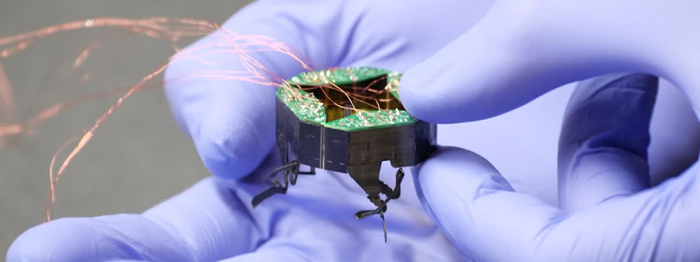Reviewed by Lexie CornerMay 1 2025
Researchers at the University of Colorado Boulder are developing tiny, shape-shifting robots inspired by insects. These robots are designed to navigate tight spaces for tasks such as locating disaster survivors or inspecting hard-to-reach components in machinery.
 Kaushik Jayaram and his colleagues debuted a small, shapeshifting robot named CLARI in 2023. The team later designed an even smaller model called mCLARI. Image Credit: Casey Cass/University of Colorado Boulder
Kaushik Jayaram and his colleagues debuted a small, shapeshifting robot named CLARI in 2023. The team later designed an even smaller model called mCLARI. Image Credit: Casey Cass/University of Colorado Boulder
Robots could be really helpful in confined spaces. If they are small enough, adaptable enough, and agile enough, they can get inside a jet engine, for example, or an underground conduit to inspect electrical pipelines.
Kaushik Jayaram, Assistant Professor Paul M. Rady, Department of Mechanical Engineering, University of Colorado Boulder
Jayaram recently received a $650,000 grant from the U.S. National Science Foundation (NSF) to develop small, shape-shifting robots capable of performing a wide range of tasks - a major step forward in advancing his research.
The funding comes from the NSF’s prestigious Faculty Early Career Development (CAREER) Program, which supports promising early-career scientists. In addition, Jayaram and collaborator Laura Blumenschein at Purdue University were awarded a $1.4 million grant in March from the U.S. Air Force Research Laboratory.
These new projects build on Jayaram’s earlier work, including mCLARI, a four-legged robot that weighs less than half a penny and is small enough to fit on top of a quarter.
However, Jayaram notes that for these robots to be truly useful, they must be more than just small - they must also be agile and adaptable. That means combining speed and strength with enough flexibility to squeeze around corners and through tight gaps. Achieving both traits at once is challenging, but that’s exactly what he aims to explore.
For inspiration, he looks to an unexpected source: insects and other small animals.
Animals combine the best of both worlds; they can be really agile, but they are also adaptable and able to respond to all kinds of new conditions. We want to build highly intelligent mechanical systems that are just like those biological systems.
Kaushik Jayaram, Assistant Professor Paul M. Rady, Department of Mechanical Engineering, University of Colorado Boulder
Spider-Bots
The influence of nature is evident in Jayaram’s lab, where three species of spiders live among the circuit boards and soldering irons: wolf spiders with their hairy legs, fishing spiders that can walk on water, and crevice weaver spiders, known for navigating burrows and narrow spaces.
Spiders are remarkably versatile. They can sprint, climb vertical surfaces, and squeeze through tight gaps by pulling in their legs to shrink their body profile. Jayaram hopes to replicate these abilities in his next generation of robots, which is supported by his recent research grants.
When mCLARI encounters a narrow space, it passively compresses its body to squeeze through. Jayaram envisions more advanced robots that can actively shift shape in response to their environment and adapt on the fly.
“If you want to be really fast, you can choose to be long and skinny,” he explains. “If you want to be stable, then you can be wide. We need robots to be smart and shapeshift.”
Future designs in his lab may not only reshape themselves using electric pulses but also walk up walls - or even across ceilings. These movements are based on static electricity, similar to what’s generated when rubbing a balloon against your hair. Jayaram’s team is also working on flexible sensor networks that wrap around the robot’s body, allowing it to perceive its surroundings in ways similar to how animals use eyes and skin.
While it may be a while before we see tiny robots crawling across airplane wings, Jayaram believes that within a decade, swarms of insect-sized machines could handle basic tasks, such as inspecting hard-to-reach areas or slipping into pipes to repair wires.
He also wants to spark interest in robotics among young students. His team has developed origami-inspired kits that let K–12 students build their own functional, insect-like robots, with as many legs as they want.
We want kids to not be afraid of computers, and we are doing that using biology, because everybody loves bugs.
Kaushik Jayaram, Assistant Professor Paul M. Rady, Department of Mechanical Engineering, University of Colorado Boulder
CLARI: The incredible, squishable robot
Video Credit: University of Colorado Boulder